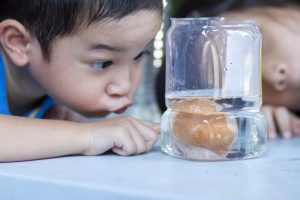Have you ever found a shell-less egg in your chicken coop? Sometimes chickens lay eggs without shells, and all that’s left behind is a thin, rubbery egg.
There are a few reasons your chickens may lay shell-less eggs: they’re new layers, they need more calcium in their diet, or they’re getting too much salt. If your chickens have been drinking softened water, that could be the reason.
If you notice thin shelled eggs, make sure your chickens get a good amount of calcium in their diet and that they’re drinking regular water that hasn’t been softened.
Not only is it exciting to find a shell-less egg in the chicken coop, but making your own shell-less eggs is fun summer learning activity you can do with your kids by doing the naked egg experiment! This super simple activity is so easy, most kids can even do it by themselves.

Naked Egg Experiment Supplies:
To do the naked egg experiment, you only need three things:
- an egg
- a glass or a jar
- plain white vinegar
The Process:
Day 1: Have your kids carefully put an egg in the jar and pour enough vinegar in the jar to completely cover the egg. You should notice that little gas bubbles (carbon dioxide) appear right away in the jar. Place the jar in safe spot and leave it alone for 24 hours.
If more than one child wants to do this experiment, I recommend giving each child their own egg and jar.
Day 2: The next day, take a look at the jar. You should see a foamy scum like substance in the jar. This is eggshell dissolving! Very carefully, pour the old vinegar out. You might want to take the egg out of the jar to see how soft it is and compare it to how it felt the day before. Put the egg back in the jar and pour fresh vinegar to cover. One more, place the jar in safe spot and leave it alone for 24 more hours.
Day 3: After 48 hours, the eggshell should be dissolved! Carefully pour off the vinegar and take out the egg. If the eggshell is gone, you’re done! If it’s not quite dissolved, cover it with fresh vinegar again and check on it one more time. Be careful with this naked egg! It’s very easy to break.
You’ve now created your own naked egg – just like the eggs you sometimes find in the chicken coop! How cool is that?
The Science:
Why does this happen? Well, eggshells are made of calcium carbonate and vinegar is an acid. When the acid in the vinegar comes into contact with the eggs, it dissolves the calcium carbonate – leaving only the egg covered in a thin membrane behind.
If you want more easy experiments to do with eggs, feel free to check out the post on my blog – 15 Science Experiments to Do With Eggs.
Do you have a favorite science experiment you like to do with eggs?